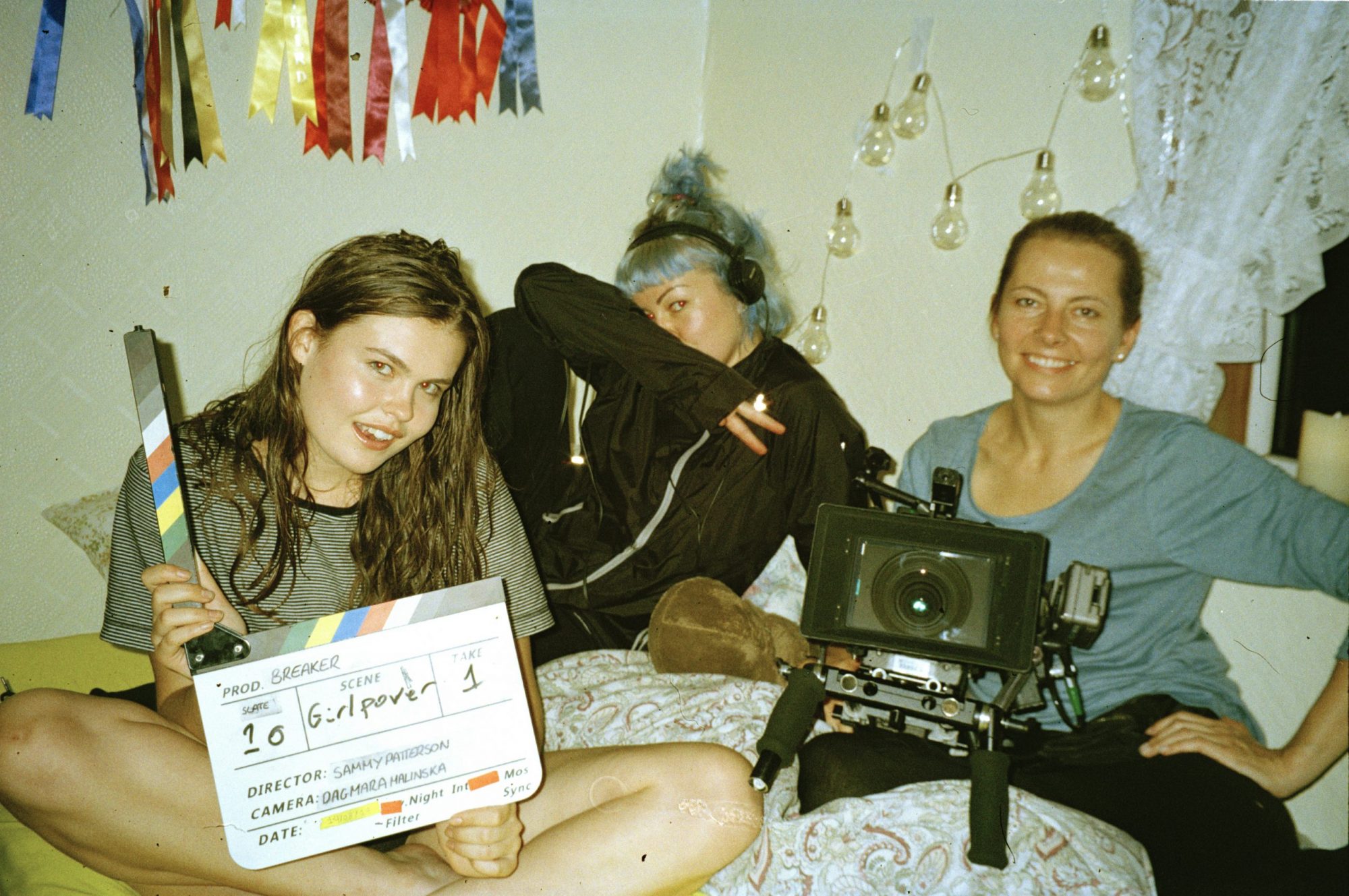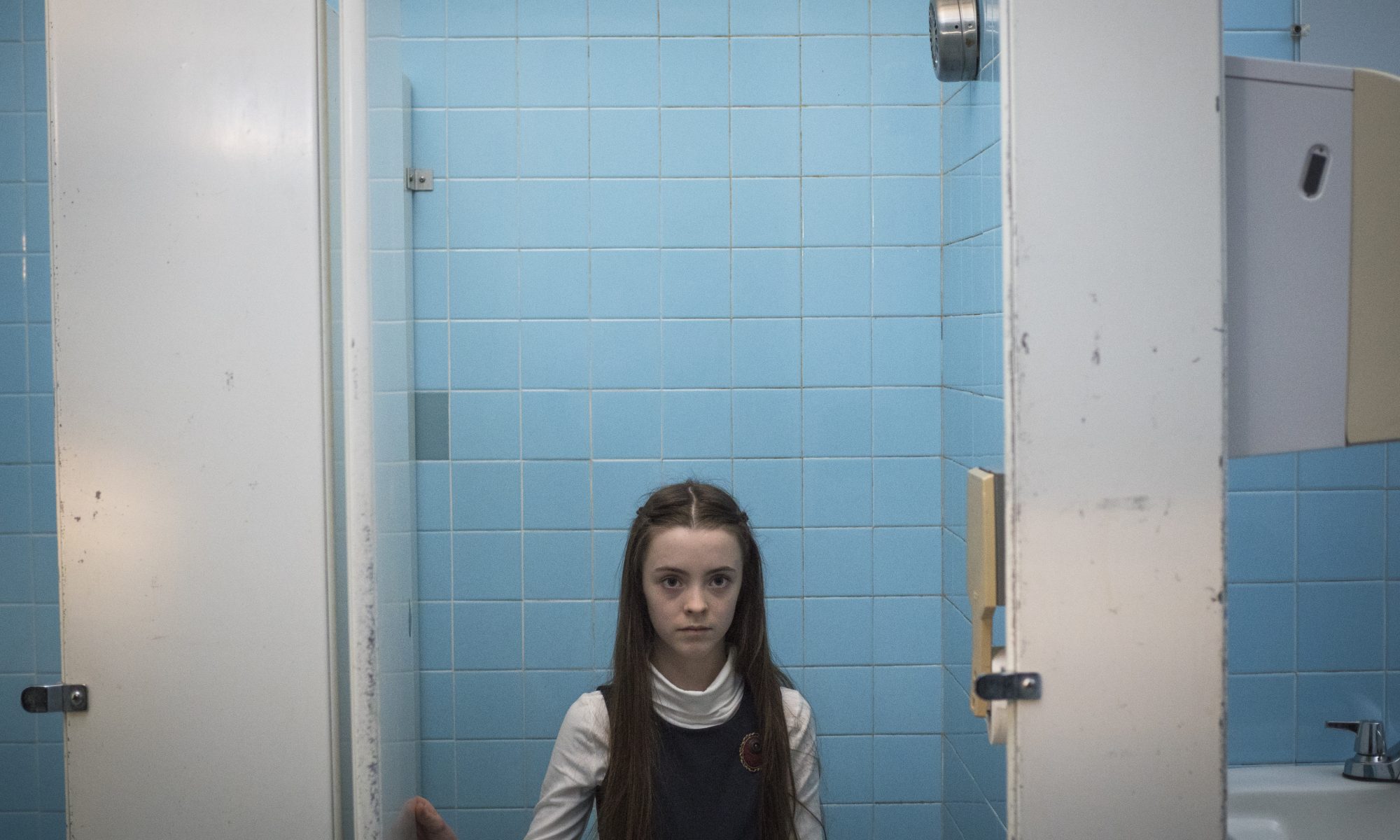Uniform
By Meghan Muldowney
Watch Practice and Dear Jesus here.

Sixth grade was the last year we wore jumpers, dresses that buttoned at the tops of our shoulders, as our school uniform. Seventh grade marked a monumental shift in many ways, but the most obvious was the uniform’s change to kilts. Some girls’ bodies already strained at the jumpers, which began to fit too tightly across the chest. Sixth grade was a liminal space between child and adolescent, a place where the ground shifted underfoot by the hour and the rules that governed childhood were no longer valid.
The boarding school students of the short film Practice also dwell in this space. They skid between the sweet goofiness of children and the precisely parroted talk of adults. Caroline and Sophie are sixth graders who not only must wear uniforms, but also have body cameras affixed to their jumpers, right above their hearts.
The body cameras capture, in muted detail, a kiss between the two girls. What could have been a private and sweet moment of two girls exploring their feelings for each other becomes a loaded encounter in the eyes of the school’s authority figures.
At this school, there is no room for anything but assiduous and rigid rule-following. Every moment of the girls’ days in front of adults becomes a performance.

The girls in my school were, too, familiar with rules. Our uniforms were expected to be impeccable, ironed and pressed. Girls consistently swiped each other’s uniforms from gym lockers when they forgot something at home, creating a daisy chain of theft, rather than risk a scolding for being “out of uniform.” There were no body cameras, or “brooches” as they’re called in the film, pinned to our uniforms, but nevertheless, our appearances were judged carefully.
In second grade, we attended a “Manners” class in which we learned how to dab – never rub – our faces with a napkin during dinner. Which fork to use and how to set a table. In fourth grade, we began ballroom dancing classes with our brother school. We bemoaned the sweatiness of the boys’ palms, which we were mostly shielded from by our dainty white gloves. These dance classes continued through sixth grade, the last year of frilly dresses and Mary Janes, before we began monthly dances with DJs and pop music, where boys and girls would eye each other from different sides of the room.
The world of Practice is perfectly orderly and painfully formal, from the counting off of repetitious exercise in gym class to the numbers the girls sing in chorus in lieu of actual song. Five, six, seven, eight, nine, they trill as one, their voices still high pitched as children. They clap politely at mealtime after a live performance of piano. But when they are alone, they laugh. They roll around and make silly faces and marvel at the mundane. They take off their shoes and sit in stocking feet on the floor while doing homework. They kiss gently in stairwells and reach for each other’s hand under the lunch table.
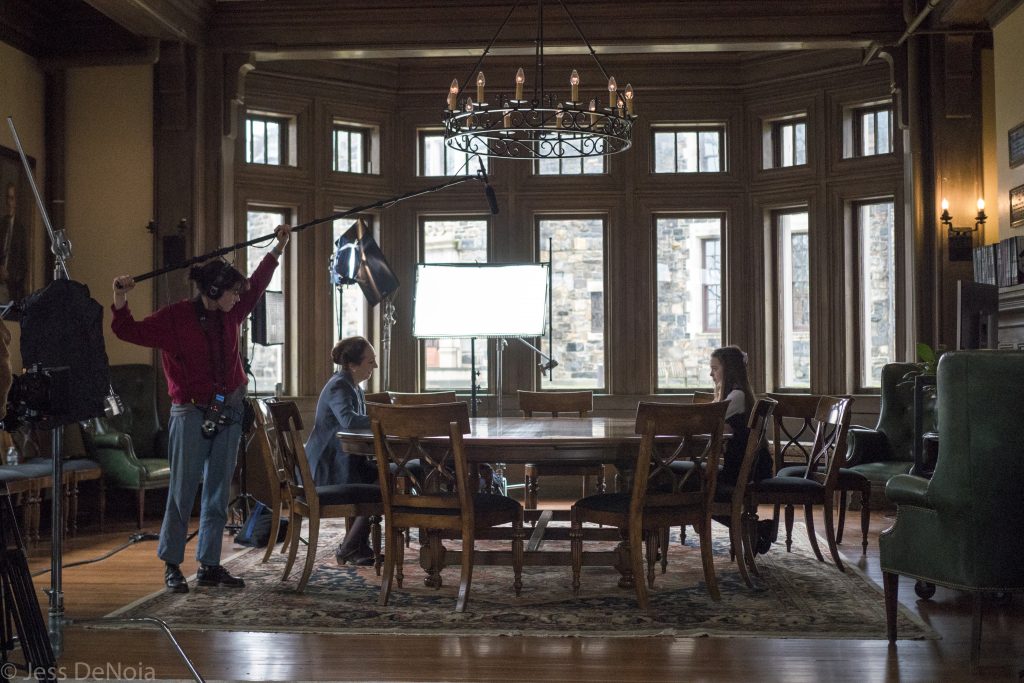
When Caroline finds herself called to the headmistress’s office, the camera’s focus is only on Caroline. The headmistress appears as an imposing authority figure, whose face is never shown. Young Caroline, with her hair in braids and a large white bow perched on her head, sits alone at a large Harkness table across from the headmistress. In the austere and old-fashioned room, under the disapproving gaze of oil paintings of previous headmasters, Caroline looks even younger than her age. She appears innocent, sweet and delicate, as she faces the careful reprimands of the headmistress.
“You know how serious the consequences are,” she says to Caroline, and the camera focuses only on Caroline’s face as she takes this in. Caroline fights hard to maintain her composure and with effort, finds an excuse to hopefully prove her innocence.
Much like Caroline, the girls I knew were all too well aware of the consequences.
Failure to maintain an acceptable academic performance would result in “not being asked back” for the following school year. It wasn’t difficult to be pulled out of class for a lecture on a child-size bench, or, worse, an appointment in the head of the Lower School’s office.
We weren’t “just kids,” we were “young ladies” who could demonstrate “behavior unbecoming of [my school’s name] girls.” As a third-grader, I found myself in the Lower School head’s office and like Caroline, I struggled to keep my composure. Tears were evidence of guilt and even worse were the hiccupping, shaky tears of children that I tried to control.
My friends and I were guilty, however. We had established a “hair braiding club,” active during recess, in which we would braid each other’s hair. Like the precocious girls we were, we had made up flyers advertising our services, and listing our titles within the club. I was “co-President.” It was great fun and I felt good to be in charge of something, however arbitrary. I was a shy child who was never the obvious star. Our excitement was not allowed to last long.
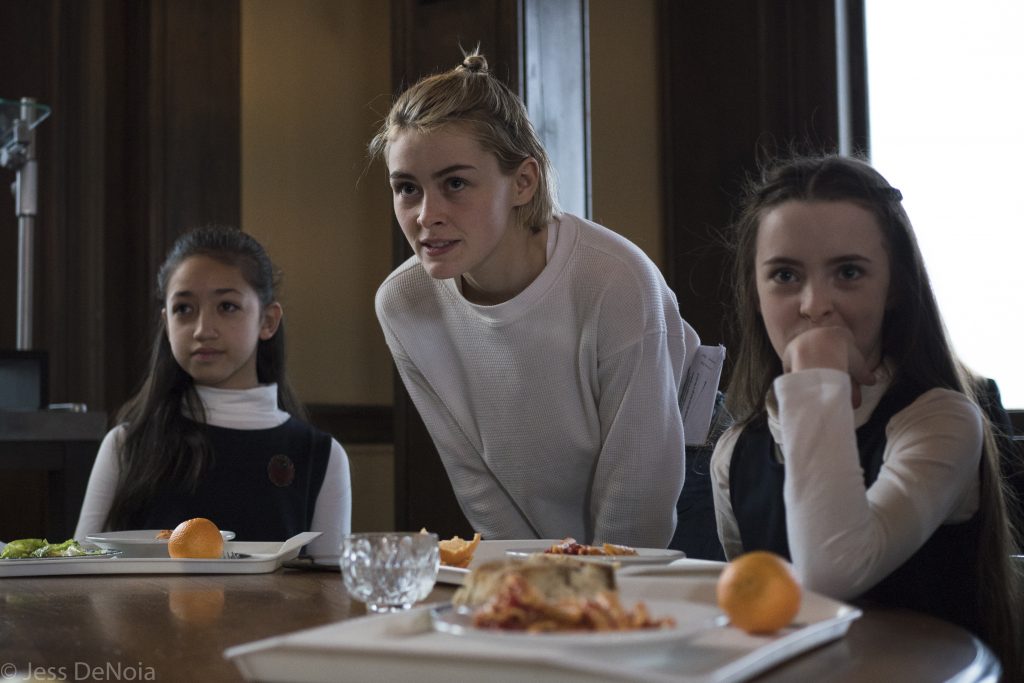
There is a sheer terror exclusive to being a small child in a large and scary room, where she is told she has done wrong. We were chastised for exclusionary behavior for assigning job titles, for “misuse of in class mailboxes,” since we had carefully placed the flyers in each student’s mailbox.
One of my friends, the oldest girl of four sisters, who was a tough and stoic protector of me, completely crumbled under the Lower School head’s reprimand. I tried to edge my chair away from her as much as I could, lest I face the same fate. I was an extremely sensitive child who was prone to catching other’s tears.
I realize now, with the benefit of 25 years, that the adults in the room might have kindly commended us on our ingenuity and drive, but explained that hair braiding among students could spread lice. We all feared lice; that was a reasoning we would have understood.
The headmistress in Practice had the same chance. To offer a kind word in an environment of strict adherence. To offer guidance rather than punishment.
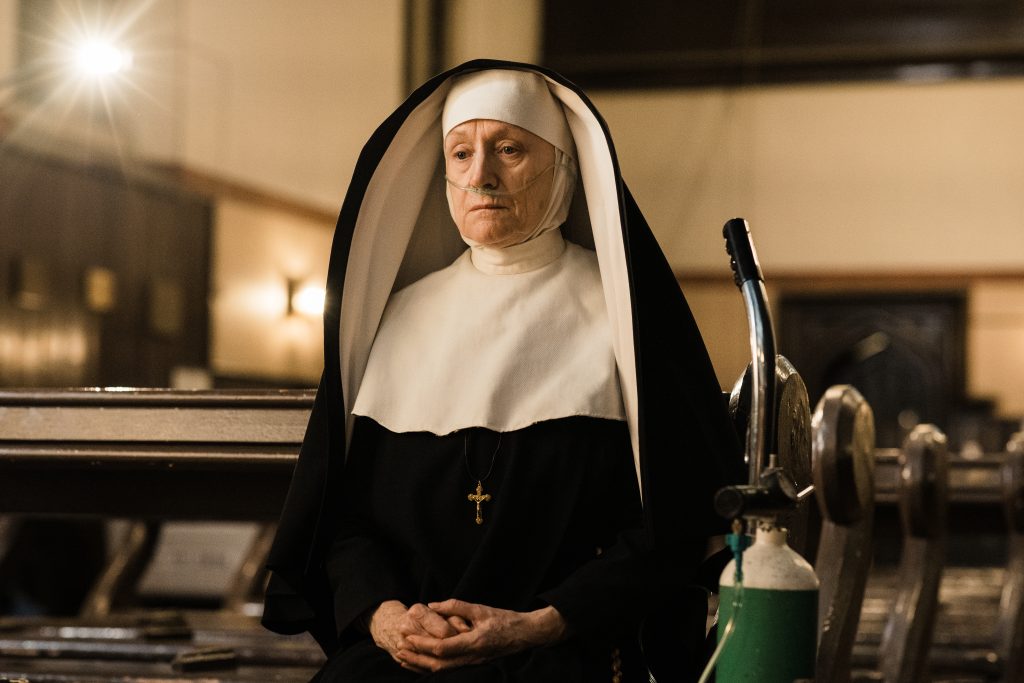
The antagonist in the short film Dear Jesus delivers a different type of punishment, but one similarly damaging. Sister Catherine, a nun and teacher, at an all-girls Catholic school claims to be a woman of God, but exhibits little warmth or affection for her students.
Sixth-grader, Ella wants desperately to be the angel—the star—of the Christmas pageant, which make her parents, particularly her mother, proud of her. She wears a felt beard as one of the villagers and endures the teasing of the more popular girls. She prays the prayers of a child—the kind that would bring a rueful smile to the faces of adults. Maybe the girl who has the role of angel could back out for some reason, Ella prays. Maybe it could be me.
When the girl is sick the next day, and the role must be recast, Ella is thrilled. Her exclamation of joy when receiving the part is immediately quieted by Sister Catherine.

The head nun’s disdain for Ella is even more apparent than the feelings of Caroline’s headmistress or my Lower School head. Ella is called into Sister Catherine’s office in front of the other girls. Upon closing the door, the nun looks carefully to make sure no one is watching, and draws the curtains over the windows.
The fear in Ella’s eyes caught my breath in my throat. She is also chastised for her unashamed delight, lack of humility, and as an afterthought, her uniform skirt being “twisted” around her waist. Sister Catherine exhibits no hesitation in telling Ella, “We have been over this. Little girls are meant to be seen and not heard.”
Ella is told to put her hands across the desk and only once protests before doing so. She cries in pain as the nun smacks her across the knuckles with a leather strap, three times. Of course, the number three has a strong importance in Catholic imagery: the three times Peter denies Jesus, the Holy Trinity of Father, Son, and Holy Spirit, and in this film, an unexpected meaning, revealed at the end.

More of Ella’s prayers are answered in unintended ways, and she finds herself buried under the weight of her guilt. Much like Caroline, and also like me, Ella is asked to be perfect—one of the polite, pretty, demure, obedient girls who are “seen and not heard,” who don’t let trouble find them, who don’t allow their consciences to drown them.
No one, of course, makes it out of middle school unscathed, but even that statement has become a cliché. It paints the entirety of the experience with a wide brush and in doing so, obfuscates the precise memories.
Step closer to the mirror by seeing these two films. See the blurry landscape of those years clarify into all-too-sharp details. Travel back to years that would rather be forgotten.
Practice and Dear Jesus are brief snapshots into the worlds of young girls, who didn’t ask to be caught in between the innocence of a child and the angst of a teenager.
The films are only ten and fifteen minutes long respectively, but both will break your heart.
Watch Practice and Dear Jesus here. Longing for more female-directed shorts? We recommend checking out Adelina, Lotus and Giving up the Ghost, which can also be found here.
